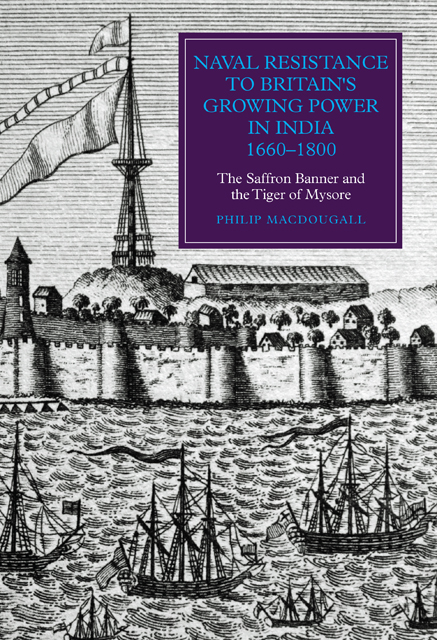 Naval Resistance to Britain's Growing Power in India, 1660–1800
Naval Resistance to Britain's Growing Power in India, 1660–1800 Published online by Cambridge University Press: 23 February 2023
A plain saffron-coloured swallowtail banner was the ensign flown by many of the fighting ships of the confederated Maratha Empire, although saffron-coloured sails were another feature of identification. The precise date of adoption is unclear, Fryer noting that in 1676 the flagship leading a thirty-strong fleet of Maratha warships flew a ‘white flag’ aloft. If nothing else, this suggests that the saffron flag, a colour sacred to Hindus and the Maratha polity, was not to regularly appear until a later date. Originally a warrior caste, the Marathas were primarily found in the Maharashtra, an area of land that had essentially fallen under the control of the Mughals at the beginning of the sixteenth century, with part also under the control of the Sultanate of Bijapur. In itself the empire was formerly established in 1674 when its founder, Shivaji Bhosale (c.1627–80), was crowned Chhatrapai (paramount sovereign). Shivaji himself was a devoted Hindu, as were, but by no means exclusively, many of his followers and those subject to his authority. Initially, Shivaji’s attempts at separating his people from the Mughals and the Sultanate for the purpose of welding them into a separate nation had seen considerable fighting within the Deccan Plateau before entering the Konkan coastal region, which brought him into contact with the European merchant trading companies together with the naval arm of both the Mughals and their allies the Siddis of Janjira.
That a Maratha fleet was created in the late seventeenth century was not, at that time, for the purpose of undermining the position of the European powers – not even that of the increasingly powerful EIC. Instead, it was designed to counter the Mughal and Siddi fleets that were being used to provision and support land forces then in conflict with the Marathas along the Konkan Coast. However, it was the rapid growth of the Maratha fleet at that time, and at a time when the EIC was still fundamentally weak, that the Marathas had their best chance of eradicating an English presence along the west coast of India. That they did not do so, and working very much to the advantage of the EIC, was due to the on-going war with the Mughals. Indeed,
To save this book to your Kindle, first ensure [email protected] is added to your Approved Personal Document E-mail List under your Personal Document Settings on the Manage Your Content and Devices page of your Amazon account. Then enter the ‘name’ part of your Kindle email address below. Find out more about saving to your Kindle.
Note you can select to save to either the @free.kindle.com or @kindle.com variations. ‘@free.kindle.com’ emails are free but can only be saved to your device when it is connected to wi-fi. ‘@kindle.com’ emails can be delivered even when you are not connected to wi-fi, but note that service fees apply.
Find out more about the Kindle Personal Document Service.
To save content items to your account, please confirm that you agree to abide by our usage policies. If this is the first time you use this feature, you will be asked to authorise Cambridge Core to connect with your account. Find out more about saving content to Dropbox.
To save content items to your account, please confirm that you agree to abide by our usage policies. If this is the first time you use this feature, you will be asked to authorise Cambridge Core to connect with your account. Find out more about saving content to Google Drive.